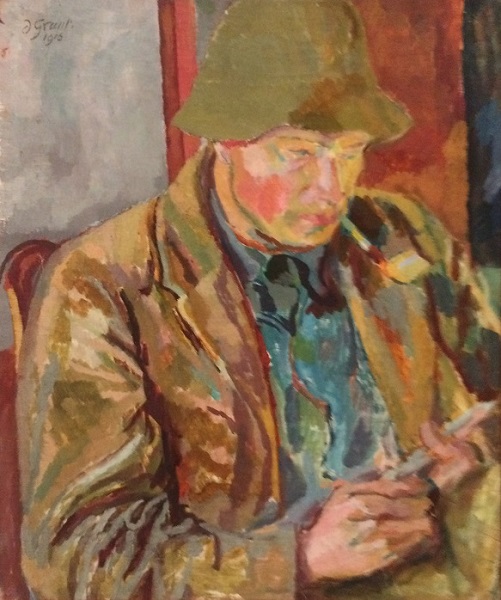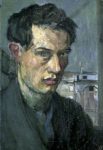
Duncan Grant
British, 1885-1978
Portrait of David Garnett, 1916
oil on canvas
30 x 25 in.
SBMA, Gift of Mrs. Philip Francis Siff
1984.6

Duncan Grant in self-portrait from 1911.
RESEARCH PAPER
Duncan Grant and Vanessa Bell frequently painted David Garnett, who Grant met in 1915. Garnett was then a young man in his twenties. Author and publisher and prominent member of the Bloomsbury Group, Garnett later received literary recognition when his novel “Lady into Fox”, an allegorical fantasy, was awarded the 1922 James Tait Black Memorial Prize for fiction. His father had recommended Virginia Woolf’s first novel for publication. In March of 1916 Grant, Garnett, and Vanessa Bell formed a “manage a trois” and moved together to Wissett Lodge in Suffolk, where the two men did work in the orchards and left part of the day for Grant to pursue his painting. In October of that year they moved to a farmhouse at Charleston, in the village of Firle, East Sussex, which became the country home of the Bloomsbury Group, a few miles away from Virginia Woolf’s country home. Here the men did heavier farm labor, which permitted less time for art. During these war years Vanessa and Grant began decorating the wall, door frames, and mantle pieces of the interior at Charleston. This design team would continue after the war, executing many decorative commissions in the next three decades. They spent time working in their studios in London and vacationed in southern France on painting excursion while maintaining their home in Charleston. Vanessa lived there until her death in 1961 and Grant continued to live there until his death in 1978. Since 1980 there has been considerable restoration work done to maintain the house at Charleston as it had been when the two artists decorated it.
The portraits of David Garnett, like this one, were painted mainly at Wissett and at Charleston. Where Vanessa simplified, Duncan used a richer surface treatment, a result of what English painter, art critic, and member of the Bloomsbury Group, Roger Fry, called his sensitive “hand-writing”. It was in this early period that Fry described Duncan as having an “exquisite sense of colour”. English art critic, Clive Bell, who was also the brother in law of Virginia Woolf and part of the Bloomsbury group, ranked Grant as a colorist on the level of Titian and Matisse! (Clive Bell also later raised Angelica Bell, the daughter of Vanessa Bell and Duncan Grant as his own.)
This portrait of David Garnett fits into this period of vivid color and vibrant brushwork inspired by French Post-Impressionism. The work seems influenced by both Cezanne and Matisse. The face in the portrait is composed of planes or patches of bright colors: red and pink, yellow and yellow-green, outlined in red and green. These colors are similar to those used in Matisse’s “Woman with the Hat” (1905) which Grant saw in Gertrude Stein’s collection when he met her in 1909. Of all the Fauve painters from 1905 – 1907, Matisse most looked to Cezanne for how to construct form through color planes. A few years later he shifted to more decorative color and flat design. Grant’s solidity of form seems derived from Cezanne’s portraits of the 1880’s and 1890’s, although Grant’s tones in modeling forms are less convincing in conveying the third dimension. His device of depicting paneling in the background also seems based on Cezanne. But his rich color and graceful linear treatment seems more allied with Matisse. As Roger Fry pointed out, his “hand-writing” was part of Grant’s unique style.
After the war, Grant’s colors became more somber, he applied paint more thickly, and he used less surface patterning in his paintings. But his decorative panels, pastels, and water colors remained as spontaneous as before.
Born in Scotland in 1885, Duncan Grant spent his early years in India where his father served as an army officer. He returned to England to attend St. Paul’s School and spent vacations with his cousins the Stracheys. This Aunt recognized his artistic bent and recommended that he attend the Westminster School of Art, where he studied for three years. In 1906, again encourage by his Strachey connections, he left for Paris to study at Jacques Emile Blanche’s school, La Palette. During this period he often visited the Caillebotte collection of Impressionists, including works by Cézannes at the Luxembourg, and saw the Salon de Independants exhibition, where he became aware of works by the Fauve group. He revisited Paris again in 1909, and again observed modern French painting at the Salon des Independants and met Gertrude stein and Matisse. At this time he was absorbing the new ideas of French modern art which influenced his work a few years later.
In the fall of 1909 Grant took a studio in London where Virginia Stephens, later Virginia Woolf, and her brother lived in Bloomsbury. This was the start of his lasting relationship with the Bloomsbury group of artists, writers, and intellectuals which centered around Virginia Woolf and her older sister, Vanessa Bell. One of the important members of this group was Roger Fry, an artist, art scholar, connoisseur, and critic, who enthusiastically embraced the work of Cézanne, and featured Cezanne’s work with other modern French painters in the first Post-Impressionist Exhibition that Fry organized in London in 1910. At this time Grant became particularly interested in Cezanne, undoubtedly due to Fry’s enthusiasm for this “originator of the whole idea of expressive form”. A year later, Grant worked with Fry on mural decoration, and in 1912 Grant exhibited six painting in Fry’s second Post-Impressionist Exhibition which was dominate by works of Matisse, Picasso and Cezanne.
In the early period Grant worked in a variety of styles as he explored the directions of these modern artists. According to contemporary art critic and essayist, Allan Clutton-Brock, in discussing Grant’s painting up until the end of the war in 1918: “Both Cubist and Fauve painting contributed much to his style, but he used their discoveries and conventions with almost as light a hand as Raoul Dufy, (a French Fauvist painter who developed a colorful, decorative style that became fashionable for designs of ceramics and textiles, as well as decorative schemes for public buildings.) His colour was almost invariably captivating; his handwriting….was fluent and graceful.” (2)
Fry’s first exhibition in 1910 introduced modern French art to a shocked public in London. The Royal Academy had remained very conservative. The most modern group before that time was the English Impressionists who were members of the New English Art Club. In 1911 the Camden Town Group, slightly more modern, was organized by Walter Sickert. Grant exhibited in their second show in 1911. With the second Post Impressionist Exhibition in 1912, the English public began to shift to being a more appreciative audience and they enthusiastically bought many of the paintings. Finally in 1915, Wyndham Lewis put on his Vorticist Exhibition which included three paintings by Grant. By the time of the First World War, modern art had begun to be established in England in this way.
In 1913 Grant joined the Omega workshops founded by Roger Fry, which was established to produce items with Post Impressionist art applied; he painted screens and pottery and designed textiles, some of which were used in costumes for theater productions. Grant continued to develop his talent for decoration throughout his career.
In assessing Grant’s body of work after viewing his retrospective at the Tate as well as his 90th birthday exhibition at the same gallery in 1975, British art critic and art historian, Richard Shone, stated: “No matter how exhilarating and fully resolved many of Grant’s pictures C. 1910 and 19916 appear to be, they are still to some extent explorations towards the style which emerged later, more complex in design”. (8) Through Grant’s close association with Roger Fry at the time when Fry was avidly promoting the new art in France, Grant was in a position to absorb the new styles and use them in his own work. Grant remains the outstanding portraitist of the Bloomsbury group and an important exponent of Post Impressionism in England, Mr. and Mrs. Philip Siff were interested in both art and literature, including the work of the Bloomsbury group of artists and writers in London. In the early 1970’s, on a trip to England, Mr. Siff met Duncan Grant and had tea with him at Charleston. He bought this painting in London and, in 1984 Mrs. Philip Siff gifted Duncan Grant’s Portrait of David Garnett to SBMA.
Prepared for the Santa Barbara Museum of Art Docent Council by Patiricia G. Cleek, April 1988
Bibliography
1. Bell, Clive, “Since Cezanne”, 1922, New York.
2. Clutton-Brock, Alan, “Duncan Grant, A Retrospective Exhibition”, 1959.
3. Fry, Roger, “Duncan Grant”, 1923, London.
4. Fry, Roger, “The French Post Impressionists”, Vision and Design, 1920, New York.
5. Garrett, David, “Flowers of the Forest”, 1955, London.
6. Mortimer, Raymond, “Duncan Grant”, 1944.
7. Shone, Richard, “Duncan Grant and the Bloomsbury Group”, 1975.
8. Shone, Richard, “Bloomsbury Portraits, Bell, Grant & Their Circle”, 1976, New York, (pg. 205.)
9. Siff, Mrs. Philip, “Oral History Interview” with Patricia Cleek, Santa Barbara, 1984.
SBMA CURATORIAL LABELS
Duncan Grant was a member of the artistic Bloomsbury Set which gathered around Virginia Wolf and her sister and brother-in-law, Clive and Vanessa Bell, Lytton Strachey and Roger Fry. During World War I Vanessa Bell bought Charleston Farmhouse in Sussex partly to enable conscientious objectors such as Grant and Garnett to work on the land rather than join the forces or be imprisoned. In the sexually complex Bloomsbury Set, Garnett and Grant were sometime lovers, but later he married Duncan and Vanessa’s daughter Angelica.
- British Modernism from Whistler to WWII, 2016
